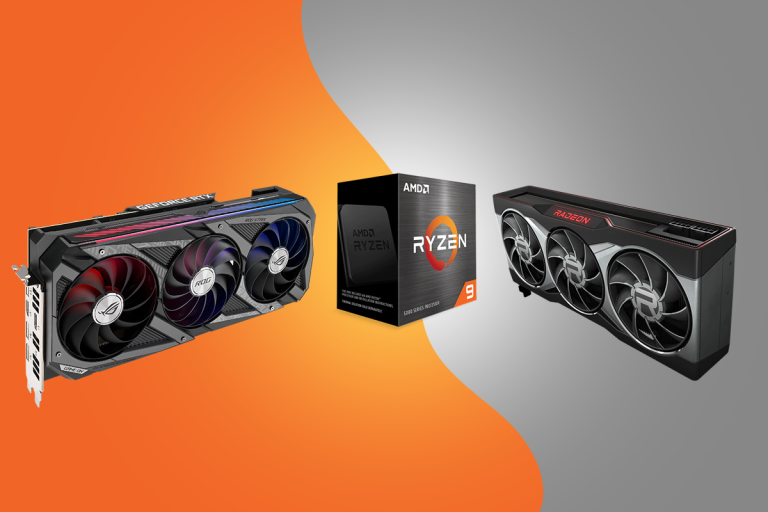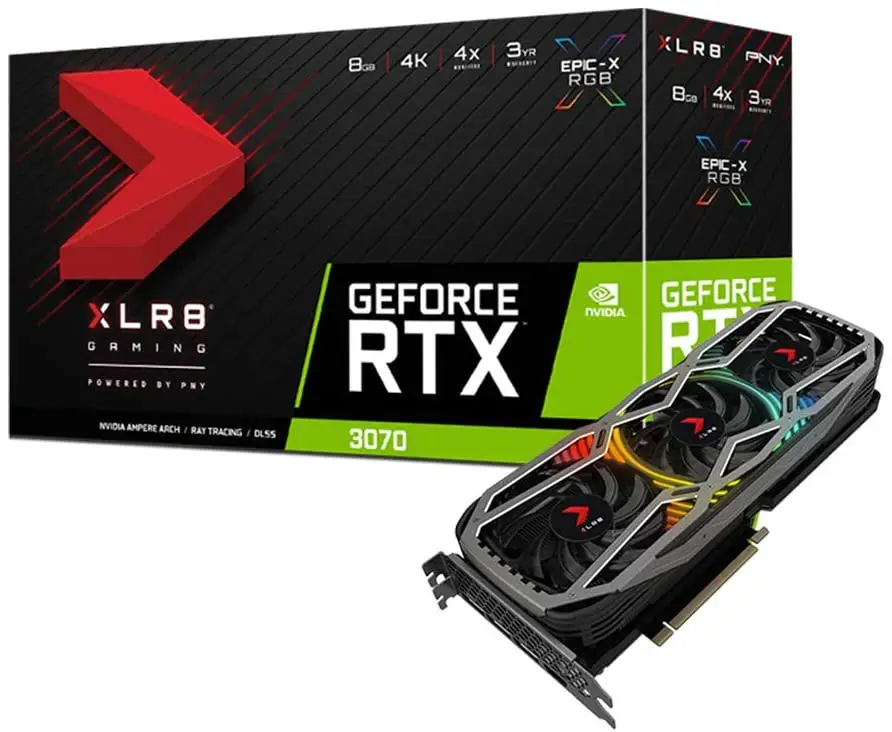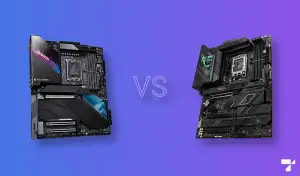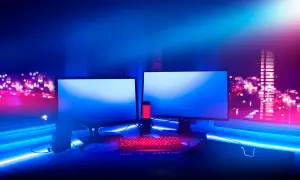AMD’s lineup of 5000s series CPUs did not end with the Ryzen 9 5900X. They also announced the exciting 16-core 5950X, a Zen 3 CPU that takes the torch from its powerful predecessor, the 3950X. Thanks to its new architecture, we expect to see a significant increase in single-thread and multi-thread performance. This time AMD worked to improve the single-thread performance, which used to be on the weaker side when compared to Intel’s CPUs. With that being said, this processor is definitely going to be popular in high-end PC builds and with 4K gaming enthusiasts, so let’s explore the best GPUs for Ryzen 9 5950X.
AMD promises a worthwhile experience considering the improvements brought by the new Zen 3 architecture and the boosted clock speeds. In addition, this year they’re launching the new 6000 series of graphics cards which, according to AMD, will benefit from additional performance when used with a Zen 3 CPU like the 5950X. This is exciting news because we’re going to have so many options to choose from when building a PC around this processor.
So, whether you’re into AMD graphics cards or a huge fan of Nvidia, this year is a good year to pick up a top-notch GPU together with the new Ryzen 9 5950X.
7 Best GPUs for Ryzen 9 5950X
1. Nvidia Geforce RTX 3090
Specifications:
Stream Processors: 10,496 | Base/Boost Clock: 1400 MHz/1700 MHz | Memory: 24 GB GDDR6X | Memory Clock: 19.5Gbps | Power Connectors: 2x PCIe 8-pin | Outputs: 1x HDMI 2.1, 3x DisplayPort 1.4aKey features:
- Nvidia DLSS (Deep Learning Super Sampling)
- Ray Tracing
- 8K gaming performance
- PCI Express 4.0 support
- RTX I/O
- Nvidia Broadcast
The RTX 3090 is Nvidia’s top performing graphics card. Built to easily handle 4K gaming and designed to be a solid option for workstations, the RTX 3090 effectively replaces the line of Titan GPUs. It’s powerful, it’s large, and it uses a whole lot of power, especially when overclocked.
The 3090 comes with an impressive 24 GB of GDDR6X memory, which is faster than GDDR6 but demands more power. Its stream processors count is just as impressive though, numbering almost 10,500 CUDA cores. These specs alone make this GPU a great choice for a workstation for 3D modelers. However, Nvidia advertises the fact that the 3090 can also handle 8K gaming, though not many games can reach 60 fps, especially on ultra high settings. But this aspect isn’t as important just yet because there are barely any monitors capable of running at 8K. Until we get more options in that department, we get to enjoy stable 4K gaming.
The RTX 3090, together with the rest of the 3000s series, benefits from improved ray tracing and super sampling technology when compared to its predecessors from the 2000s series, thus delivering higher quality graphics than ever before. Furthermore, Nvidia introduced the RTX I/O technology which can greatly boost the frame rates and performance because it allows data to travel from the SSD straight to the GPU and therefore reducing input latency.
While the specs and software improvements are mesmerizing, for most gamers and PC users the RTX 3090 is a bit overkill, especially when considering the price. In addition, the GPU requires 350W of power on its own when under heavy loads, so you would need to invest in a powerful PSU to avoid computer crashes and other problems. With that being said, if the the RTX 3090 is within the budget, it makes a good combo with the Ryzen 9 5950X, making your system future-proof for the next few years.
2. AMD Radeon RX 6900 XT Graphics
Specifications:
Stream Processors: 5,120 | Base/Boost Clock: 2015 MHz/2250 MHz | Memory: 16 GB GDDR6 | Memory Clock: 16Gbps | Power Connectors: 2x PCIe 8-pin | Outputs: 1x HDMI 2.1 VRR and FRL, 2x DisplayPort 1.4aKey features:
- Radeon Image Sharpening
- Radeon Anti-Lag
- Ray Tracing support
- Smart Access Memory
- Radeon Boost
AMD came up with a behemoth of its own in an attempt to rival Nvidia’s RTX 3090, and that’s the RX 6900 XT. This GPU is designed as a high-end product for enthusiasts looking for the best specs. While the 6900 XT certainly looks impressive, it doesn’t seem that much above the 6800 XT. It has the same clock speeds, memory, and cash. The difference lies in the higher stream processor count and higher compute units count. For the average gamer, that might not be enough to justify paying a higher price, but for those looking to squeeze every bit of juice out of a new GPU, it may suffice.
The RX 6900 XT relies on the RDNA 2 architecture that allows the card to perform more efficiently. Its per Watt performance is much higher than what we see in the previous generation of AMD GPUs. In addition, the many software improvements, such as smart access memory and Radeon Boost, together with the massive 128MB cache, compensates for the 6900’s 16GB of GDDR6 memory, which is slower than the 24GB of GDDR6X memory the RTX 3090 has.
It remains to be seen whether the RX 6900 XT can outperform the RTX 3090, but considering its price was announced to be $500 lower, it may still be a great option even if it fails to take the crown. What we do know so far is that this GPU will effortlessly handle 4K resolutions, and when paired with a powerful CPU like the Ryzen 9 5950X it becomes a great workstation candidate.
3. Nvidia Geforce RTX 3080
Specifications:
Stream Processors: 8,704 | Base/Boost Clock: 1440 MHz/1710 MHz | Memory: 10 GB GDDR6X | Memory Clock: 19Gbps | Power Connectors: 2x PCIe 8-pin | Outputs: 1x HDMI 2.1, 3x DisplayPort 1.4aKey features:
- Nvidia DLSS (Deep Learning Super Sampling)
- Ray Tracing
- Nvidia Reflex
- PCI Express 4.0 support
- RTX I/O
- Nvidia Broadcast
The Ryzen 9 5950X is a powerful CPU and it deserves an equal GPU. Nvidia’s flagship, the RTX 3080 may be one of the best choices to go with this processor. Its performance isn’t that far off from the 3090, with memory being an exception, and it’s certainly more affordable. After all, the 3080 delivers more than the 2080 TI did and costs less. That alone should give you a rough idea about this GPU’s performance and popularity.
The RTX 3080 is capable of 4K gaming as well thanks to the high number of CUDA cores, high clock speeds, and fast GDDR6X memory which is a step up from the GDDR6 memory. Furthermore, it requires less power than the RTX 3090, so finding the right PSU according to your budget is going to be a much easier mission.
While these impressive technical specs come in an affordable package, the RTX 3080 also benefits from the same software improvements we see with the RTX 3090, including RTX I/O. The architecture of this GPU combined with a next-gen CPU like the Ryzen 9 5950X guarantees a future-proof PC build that can handle 4K resolutions as well as heavy rendering workloads.
4. AMD Radeon RX 6800 XT Graphics
Specifications:
Stream Processors: 4,608 | Base/Boost Clock: 2015 MHz/2250 MHz | Memory: 16 GB GDDR6 | Memory Clock: 16Gbps | Power Connectors: 2x PCIe 8-pin | Outputs: 1x HDMI 2.1 VRR and FRL, 2x DisplayPort 1.4aKey features:
- Radeon Image Sharpening
- Radeon Anti-Lag
- Ray Tracing support
- Smart Access Memory
- Radeon Boost
With the announcement of AMD’s new RX 6000s series comes a rival for Nvidia’s RTX 3080, the RX 6800 XT. With a high boost clock frequency reaching a maximum of 2250 MHz, this 16GB beast is designed to be an affordable solution for 4K gaming systems. However, despite the higher boost clock and memory, AMD chose to go with the slower and less power hungry GDDR6 instead of GDDR6X like Nvidia did. But this isn’t a major drawback, because the RX 6800 XT comes with an impressive 128MB cache to compensate.
Furthermore, AMD slightly undercuts Nvidia’s competing RTX 3080 by a marginal sum, as is tradition. But that doesn’t mean it comes with fewer features. In fact, AMD finally introduces their own ray tracing support, as well as smart access memory, to improve the quality of the graphics and to reduce loading times. The 6000s series seems to be on par with the RTX 3000s series, but there aren’t enough benchmarks and real-world comparisons to come up with a definitive conclusion.
Furthermore, AMD added another exciting feature, namely Radeon boost, which intelligently improves in-game performance by automatically downscaling the render resolution during camera movement and then upscaling it back when the player is motionless. In other words, we should see a significant difference in frame rates when turning this feature on, but it’s likely going to depend on each game.
With that being said, with the RX 6800 XT AMD is back in the race. If you’re into 4K gaming and if you want to take advantage of AMDs hardware optimizations, the next gen 6800 XT is ideal when paired with the Ryzen 9 5950X.
5. Nvidia Geforce RTX 3070
Specifications:
Stream Processors: 5,888 | Base/Boost Clock: 1500 MHz/1730 MHz | Memory: 8 GB GDDR6 | Memory Clock: 14Gbps | Power Connectors: 1x PCIe 8-pin | Outputs: 1x HDMI 2.1, 3x DisplayPort 1.4aKey features:
- Nvidia DLSS (Deep Learning Super Sampling)
- Ray Tracing
- Nvidia Reflex
- PCI Express 4.0 support
- VR Ready
- Nvidia Broadcast
The RTX 3070 is the budget-friendly next-gen GPU from Nvidia, which is intended to replace the RTX 2080 TI at a modest price. This aspect alone makes it popular among 1080p and 1440p gamers. However, the 3070 is capable of running games at 4K resolutions, though some of them may not reach 60 FPS at ultra high settings, and it also comes with PCI Express 4.0 support. So even though it’s not as powerful as the 3080, it still beats its predecessor, the RTX 2070, and is future-proof due to all the next-gen features it comes with.
Speaking of features, Nvidia provided the 3070 with the same software features as the bigger and more expensive GPUs in the series. It comes with improved ray tracing, super sampling, RTX I/O, as well as features that are useful outside of gaming, like Nvidia Broadcast.
All in all, the RTX 3070 is one of the best choices for gamers who don’t care much about 4K setups, and who just want to have a reliable computer for the next several years.
6. AMD Radeon RX 5700 XT Graphics
Specifications:
Stream Processors: 2,560 | Base/Boost Clock: 1605 MHz/1905 MHz | Memory: 8 GB GDDR6 | Memory Clock: 14Gbps | Power Connectors: 1x PCIe 8-pin and 1x PCIe 6-pin | Outputs: 1x HDMI, 3x DisplayPort 1.4Key features:
- Radeon Image Sharpening
- Radeon Anti-Lag latency reducer
- PCI Express 4.0 support
- Energy efficient
- VR Ready
While we’re all excited about the new Zen 3 processors from AMD, it might take some time before all of us can get our hands on an RTX 3000s series GPU or one of AMD’s newly announced 6000s series. With that being said, the RX 5700 XT graphics card is a solid option, despite the fact that it’s not the most up to date piece of hardware.
The RX 5700 XT is a capable GPU that can be compared to the RTX 2070 in terms of performance. This means that it’s a solid choice for anything other than 4K gaming. The good news is that it supports PCI Express 4.0, making it somewhat future-proof, or shall we say near future-proof.
Despite its high clock speeds and PCI 4.0 support however, this GPU lacks ray tracing, so if that’s something you really want, this graphics card isn’t the right choice. It does somehow compensate with AMD’s own image sharpening and anti-lag latency reduction software though. So for competitive gamers that don’t need the best graphics possible but need high frame rates and low latency, this GPU actually comes with an advantage over others.
In essence, the RX 5700 XT is a great mid range GPU that can offer a solid experience outside of 4K gaming, especially when paired up with a powerful CPU like the Ryzen 9 5950X.
7. Nvidia Geforce RTX 2070 Super
Specifications:
Stream Processors: 2,560 | Base/Boost Clock: 1605 MHz/1770 MHz | Memory: 8 GB GDDR6 | Memory Clock: 14Gbps | Power Connectors: 1x PCIe 8-pin and 1x PCIe 6-pin | Outputs: 1x HDMI 2.0b, 3x DisplayPort 1.4aKey features:
- Nvidia DLSS
- Ray Tracing
- Nvidia Adaptive Shading
- Nvidia SLI-Ready
- VR Ready
As an alternative for the RX 5700 XT for those who want the ray tracing feature we have the RTX 2070 Super. But this GPU actually has more than that. The Super edition also comes with some of the improved software we find in the 3000s series. It’s a 2070 card that was boosted close to the 2080’s specs and that was brought up to date in terms of AI-driven software.
The RTX 2070 Super is ideal for 1440p gaming, but it can handle 4K resolutions to some degree, especially if reducing the settings down to high or even medium. It can also be used by 3D modelers that don’t deal with enough time-consuming rendering tasks to build a modest budget-friendly workstation.
On the downside, this GPU costs nearly as much as the next gen RTX 3070, so buying it instead of the newer model might not make that much sense in the long run. However, prices are bound to drop in the near future as third party companies start selling their own versions of the 3070 and as Nvidia’s stock improves. At that point, the price difference might be worth it for those who want to invest their money into a powerful CPU like the 5950X instead of a top tier GPU.
Final Thoughts
The Ryzen 9 5950X is the most powerful Zen 3 processor to date, making it a great option for high-end gaming as well as various workstations. Together with the right GPU we can enjoy a smooth 4K experience and make sure that we have a future-proof build that will perform for a few years. With that in mind, there’s more testing to be done with AMDs new 6000s series of GPUs, so waiting for their release before making a decision might be the best idea. Lastly, you can use this bottleneck calculator to determine which of the GPUs above is best for your Ryzen 9 5950x.




